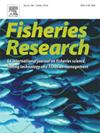Exploring the use of Fourier transform near infrared spectroscopy for aging Newfoundland and Labrador Atlantic cod (Gadus morhua)
IF 2.2
2区 农林科学
Q2 FISHERIES
引用次数: 0
Abstract
Fourier transform near-infrared spectroscopy (FT-NIRS) is a new tool for aging fish otoliths which has been shown to be potentially faster than counting otolith annuli (traditional aging) while having similar accuracy and precision. We investigated the use of FT-NIRS for aging Atlantic cod (Gadus morhua) otoliths from North Atlantic Fisheries Organization (NAFO) Divisions 2J, 3K, 3L, 3N, 3O, and 3Ps. Two types of calibration models (partial least squares (PLS) regression and principal component analysis combined with multinomial regression) were fit between traditional age estimates for otoliths and either their full FT-NIR spectra or an informative region of their spectra. Model fits were compared across calibration model types, portion of spectra used, and between models fit to individual versus all NAFO Divisions combined. A time-cost analysis comparing traditional aging versus combinations of FT-NIRS and traditional aging was performed. Good model fits (root mean square error ≤ 1; adjusted-R2 ≥ 0.85) were generally achieved for at least one calibration model fit across all NAFO Divisions and for individual Divisions. PLS and multinomial calibration model performances were very similar for models fit across all NAFO Divisions, but varied due to small sample sizes for individual Divisions. Portion of the FT-NIR spectra used to fit models had the least impact. Time-cost analysis suggested that labour savings of 23 % (6 calibration models) to 40 % (1 calibration model) could be obtained. Our results show the FT-NIRS provides reliable age estimates for Atlantic cod with similar accuracy and precision to traditional aging while also providing labour cost savings.
傅里叶变换近红外光谱在纽芬兰和拉布拉多大西洋鳕鱼老化研究中的应用
傅里叶变换近红外光谱(FT-NIRS)是一种用于鱼类耳石老化的新工具,已被证明比计算耳石环空(传统老化)更快,同时具有相似的准确性和精度。我们对来自北大西洋渔业组织(NAFO) 2J、3K、3L、3N、30和3Ps分部的老化大西洋鳕鱼(Gadus morhua)耳石进行了FT-NIRS研究。两种类型的校准模型(偏最小二乘回归和主成分分析结合多项式回归)在耳石的传统年龄估计与其完整的FT-NIR光谱或其光谱的信息区域之间进行拟合。模型拟合比较了不同的校准模型类型、使用的光谱部分,以及个体模型与所有NAFO部门组合模型之间的拟合。进行了时间成本分析,比较传统老化与FT-NIRS和传统老化的组合。模型拟合好(均方根误差≤1;校正后的r2≥0.85)对于所有NAFO分部和个别分部的至少一个校准模型拟合通常达到。PLS和多项校准模型的性能非常相似,适合所有NAFO部门的模型,但由于单个部门的样本量小而有所不同。用于拟合模型的部分FT-NIR光谱影响最小。时间成本分析表明,可以节省23 %(6个校准模型)至40 %(1个校准模型)的劳动力。我们的研究结果表明,FT-NIRS为大西洋鳕鱼提供了可靠的年龄估计,其准确度和精度与传统老化相似,同时还节省了劳动力成本。
本文章由计算机程序翻译,如有差异,请以英文原文为准。
求助全文
约1分钟内获得全文
求助全文
来源期刊

Fisheries Research
农林科学-渔业
CiteScore
4.50
自引率
16.70%
发文量
294
审稿时长
15 weeks
期刊介绍:
This journal provides an international forum for the publication of papers in the areas of fisheries science, fishing technology, fisheries management and relevant socio-economics. The scope covers fisheries in salt, brackish and freshwater systems, and all aspects of associated ecology, environmental aspects of fisheries, and economics. Both theoretical and practical papers are acceptable, including laboratory and field experimental studies relevant to fisheries. Papers on the conservation of exploitable living resources are welcome. Review and Viewpoint articles are also published. As the specified areas inevitably impinge on and interrelate with each other, the approach of the journal is multidisciplinary, and authors are encouraged to emphasise the relevance of their own work to that of other disciplines. The journal is intended for fisheries scientists, biological oceanographers, gear technologists, economists, managers, administrators, policy makers and legislators.
 求助内容:
求助内容: 应助结果提醒方式:
应助结果提醒方式:


